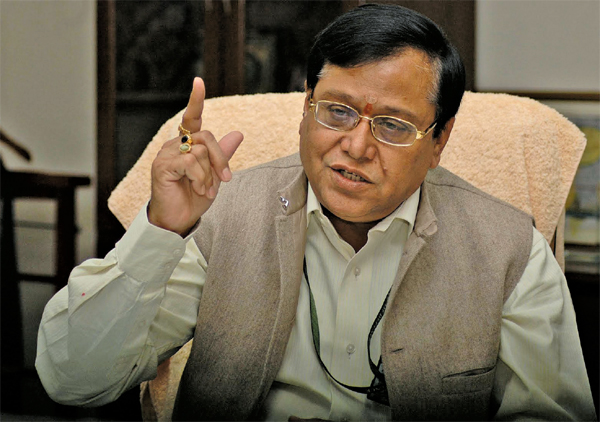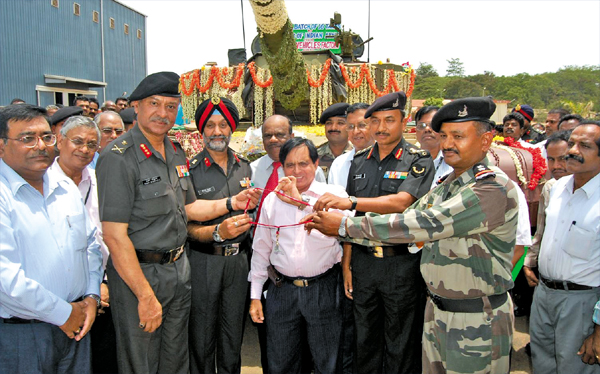|
DRDO Director General and Scientific Adviser
to the Defence Minister Dr VK Saraswat told India
Strategic that in terms of range,
the Indian scientists had achieved whatever was
assigned by the Government (about 5,000 km) but
the effort was now to develop the MIRV capability.
“The building blocks from boosters to radars,
seekers and sophisticated mission control centres
are there.

” Dr Saraswat, who has just been awarded the
country’s one of the highest achievement awards,
the Padma Bhushan, said that DRDO had been able
to develop key RF (Radio Frequency) seeker technologies
for missiles in cooperation with Russia, and that
in the last missile test, the seeker used was
made in India. Digital processing in any case
is based on DRDO’s own software.
Without the seekers, a missile would be an aimless
vehicle.
The RF and IR (Infra Red) seekers are meant for
proximity and precision engagement of targets,
and both these technologies are required for the
anti-ballistic missile (ABM) capability as well
as all kinds of missiles. He did not give details
but said that India was working on some seeker
technologies with other countries also.
“Today, we are able to design and develop RF
seekers, and in about a year or so, we will be
independent in this key technology,” Dr Saraswat
said in an interview with India
Strategic.
As for an ABM shield, he said that DRDO had conducted
four endo-atmospheric (within the atmosphere)
and two exo-atmospheric (outside the atmosphere)
missile interception tests and that all these
six had been successful. “We certainly need more
tests but we can say we have been successful in
developing this capability.”
The last one, designated Advanced Air Defence
(AAD) interceptor missile, and fired on November
23, was in fact a hit-to-kill test.
So far, DRDO has mostly been working on proximity,
near-miss or zero-miss acquisition of targets.
With these systems, an ABM missile blows itself
within a few meters of the targets – less than
9 meters. From now on, the effort is to develop
the hit-to-kill capability by directly impacting
hostile targets.

DRDO is working on Long Range and Medium Range
missiles with Israel and for Short Range missiles
with France.
But Dr Saraswat pointed out that India was not working
on an ASAT (Anti- Satellite) missile.
On radars, he disclosed that India had initially
worked with the Israelis to acquire some technology
and skills, but now, DRDO had made-in-India long
range radars which can discern between aircraft,
missiles and other flying objects. The ABM shield
being developed has overlapping radar coverage
as one cannot “allow any corridors for a missile
to slip in.”
He said that DRDO is a technology developer and
essentially, it is up to the industry – public
and private – to build systems for the users,
that is the armed forces.
For instance, after supplying 119 Arjun Mark-I
tanks – the order initially was for 124 – DRDO
is now developing the Arjun Mark-II, and nearly
80 percent of the improvements/changes sought
by the Indian Army had already been incorporated.
Work on the remaining features is underway and
this summer, there would be trials to satisfy
the user requirements.
The Arjun Mark-I has already outperformed the
T-90, and the Mark-II would have enhanced night
fighting capabilities with advanced equipment
for the gunner, driver and commander. There will
be better rough terrain and amphibious (fording)
mobility, better surveillance and firing capability
as well as increased protection.
An agreement is in place with the Army for another
lot of 118 – or two regiments – of Arjun Mark
II tanks. The Mark-II has a better 120 mm gun,
capable of firing anti-tank guided missiles (ATGMs).
DRDO was examining offers from Israel and Belarus
for the new ATGMs. As for aircraft, Dr Saraswat
said that he expected the Light Combat Aircraft
(LCA) Tejas to get the Final Operational Clearance
(FOC) in 2014, and Initial Operational Clearance
(IOC) within 2013. The aircraft is designed by
DRDO’s Aeronautical Development Agency (ADA) and
is to be manufactured by HAL as a 4-plus generation
aircraft.
Effort is also on to further develop Rustam,
DRDO’s unmanned aerial vehicle. The Indian Air
Force (IAF) is keen for an armed version, or UCAV
(Unmanned Combat Aerial Vehicle).

Dr Saraswat said that DRDO was in talks with
US Boeing for a transonic wind tunnel for supersonic
aircraft testing. If the agreement comes through,
it will help in easing the queuing problems in
testing various systems.
The tunnel is being offered as part of offsets
for Boeing aircraft that India is buying.
India has only one wind tunnel, a trisonic one,
at the National Aerospace Laboratories (NAL) in
Bangalore. Set up by NAL’s first director Dr P
Nilakantan, it was commissioned in 1967, and is
among the most-used facility of its kind in the
world.
DRDO is also working on Artificial Intelligence
and robotics. But that would take time. Nonetheless,
he observed that in the coming decades, swarms
of armed drones would be independently capable
of doing big battles by themselves, and without
any guidance or commands from their mission control
centres.
The emphasis right now is to meet the immediate
and foreseeable requirements of the Indian armed
forces. “We give them inputs, take some inputs,
discuss with them, and then plan what needs to
be done,” Dr Saraswat said, adding: “We do have
a DRDO Vision 2050 document” but DRDO makes its
strategy based on the Long Term Integrated Perspective
Plans of the armed forces.
|